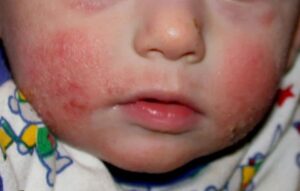SHARE WITH FRIENDS:
Exudative-catarrhal diathesis - is manifested by damage to the skin and mucous membranes as a result of allergic reactions and prolonged inflammatory processes. This type of diathesis most often occurs in young children and passes around the age of 3-4 years.
Exudative-catarrhal diathesis in the form of seborrheic dermatitis in one-month-old children - oily itching occurs in the hairy part of the head, in the upper area. Usually, the outcome of such pathology is positive, but in some children it is seborrheic eczema
and swelling, redness, and watery blisters appear on the neck, ears, and forehead.
The most severe manifestation of exudative-catarrhal diathesis is pediatric eczema. With age, this process can turn into neurodermatitis.
Children with diathesis are prone to respiratory diseases (pneumonia, bronchitis, tonsillitis, pharyngitis).
